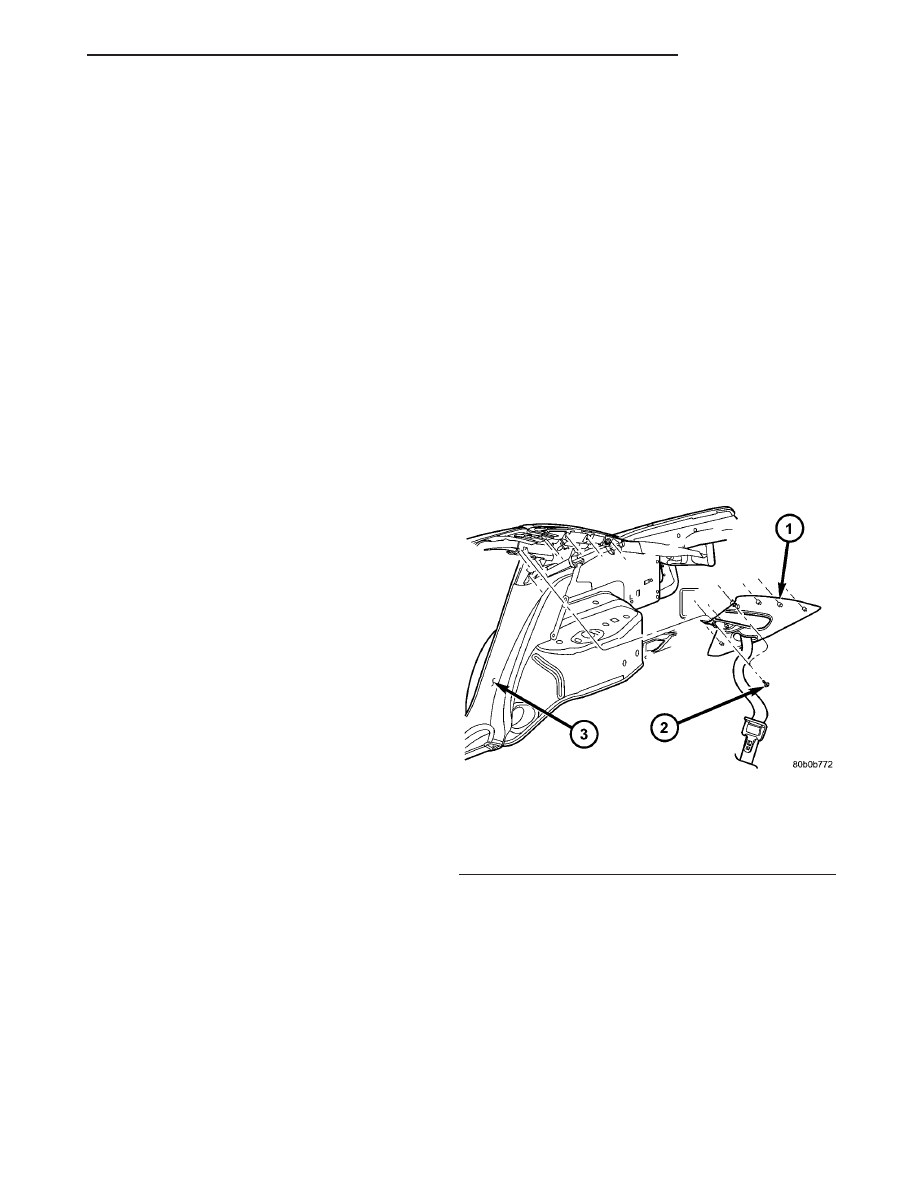Chrysler Sebring, Stratus sedan, Sebring Convertible. Manual - part 675

UPPER B-PILLAR TRIM
REMOVAL
(1) Remove the door opening weatherstrips. (Refer
to
23
-
BODY/WEATHERSTRIP/SEALS/DOOR
OPENING WEATHERSTRIP - REMOVAL)
(2) Pry shoulder belt knob straight off height
adjuster using a trim stick (C-4755).
(3) Remove seat belt turning loop cover.
(4) Remove bolt attaching turning loop to height
adjuster.
(5) Remove bolt attaching seat belt lower anchor to
floor.
(6) Disengage clips attaching upper B-pillar trim
to B-pillar.
(7) Remove upper B-pillar trim from vehicle (Fig.
1).
INSTALLATION
(1) Place upper B-pillar trim into position.
(2) Engage clips attaching upper B-pillar trim to
B-pillar.
(3) Install bolt attaching seat belt lower anchor to
floor.
(4) Install bolt attaching turning loop to height
adjuster.
(5) Install seat belt turning loop cover.
(6) Push shoulder belt knob straight on height
adjuster.
(7) Install the door opening weatherstrips. (Refer
to
23
-
BODY/WEATHERSTRIP/SEALS/DOOR
OPENING WEATHERSTRIP - INSTALLATION)
UPPER DECK MOLDING
REMOVAL
(1) Lower convertible top to midway position.
(2) Remove screws attaching upper deck molding
to rear deck panel above convertible top rear attach-
ment.
(3) Open decklid.
(4) Remove screws attaching upper deck molding
to rear deck panel inside decklid water trough.
(5) Disconnect wire connector for CHMSL.
(6) Remove upper deck molding from vehicle.
INSTALLATION
(1) Position upper deck molding on vehicle.
(2) Connect wire connector for CHMSL.
(3) Install screws attaching upper deck molding to
rear deck panel inside decklid water trough.
(4) Install screws attaching upper deck molding to
rear deck panel above convertible top rear attach-
ment.
(5) Raise and secure convertible top.
UPPER QUARTER TRIM
REMOVAL
(1) Remove the door opening weatherstrips as nec-
essary.
(Refer
to
23
-
BODY/WEATHERSTRIP/
SEALS/DOOR
OPENING
WEATHERSTRIP
-
REMOVAL)
(2) Remove rear seat cushion. (Refer to 23 - BODY/
SEATS/REAR SEAT CUSHION - REMOVAL)
(3) Remove bolt attaching rear seat belt anchor to
floor. (Refer to 8 - ELECTRICAL/RESTRAINTS/
SEAT BELT - REMOVAL)
(4) On vehicles equipped with a side curtain air
bag, open the screw cap covers and remove the
screws (Fig. 27).
(5) Fold the seat back down.
(6) Disengage clips attaching upper quarter trim
to inner quarter panel (Fig. 27) and (Fig. 28).
(7) Route seat belt webbing through access hole in
upper quarter trim.
(8) Remove upper quarter trim panel from vehicle.
INSTALLATION
(1) Place upper quarter trim panel into position.
(2) Route seat belt webbing through access hole in
upper quarter trim.
(3) Engage clips attaching upper quarter trim to
inner quarter panel.
(4) On vehicles equipped with side curtain air bag,
install the screws and close the screw cap covers.
(5) Install bolt attaching rear seat belt anchor to
floor. (Refer to 8 - ELECTRICAL/RESTRAINTS/
SEAT BELT - INSTALLATION)
(6) Install rear seat cushion. (Refer to 23 - BODY/
SEATS/REAR SEAT CUSHION - INSTALLATION)
Fig. 27 UPPER QUARTER TRIM W/CURTAIN AIR
BAG
1 - UPPER QUARTER TRIM PANEL
2 - SCREWS
3 - C-PILLAR LOWER
JR
INTERIOR
23 - 97